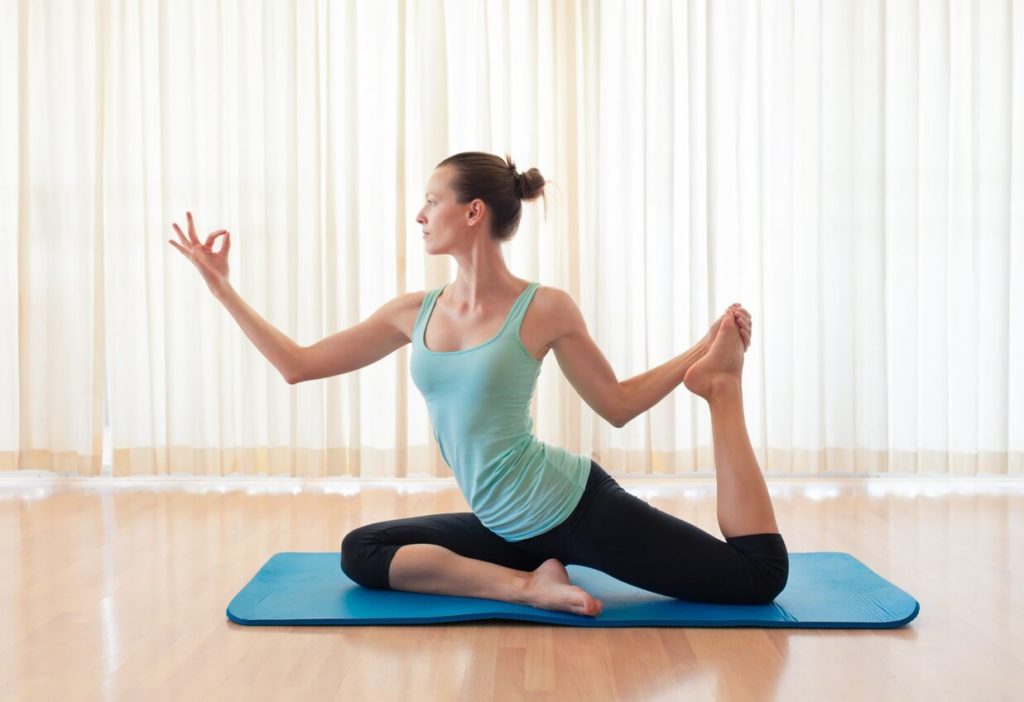Yoga Nidra: solution to fight against stress?
Written by: Loris Vitry (holistic coach)
Validated by: Cathy Maillot (Osteopath)
Caution: If you have any medical questions or concerns, please speak to your doctor. Even if the articles on this site are based on scientific studies, they do not replace professional medical advice, diagnosis or treatment.

Headache, dizziness, nausea, insomnia, intense fatigue …
A whole series of symptoms which often reveal a state of daily stress.
A situation experienced by many people over a short period of time and which sometimes requires the use of meditation.
Indeed, Yoga and particularly Yoga Nidra, is a natural alternative to taking medication to get rid of stress.
This complete guide takes stock of Yoga Nidra and its anti-stress properties.
What is Yoga Nidra?
Origins
An ancient meditation from India, Yoga Nidra is a technique created in 1950 by Swami Satyananda.
It thus finds its origins in the village of Sanskrit, in the North of India.
The practice of Yoga Nidra stems from the adaptation of “Nyasa” (an ancestral practice based on massage) with breathing exercises.
Its initiator Swami Satyananda also had recourse to sacred hymns (mantras) in audio to develop his technique.
Since then, Yoga Nidra has been introduced all over the world and today has thousands of followers around the world.
Now, it is recognized as one of the most effective deep relaxation techniques.
Definition
Yoga Nidra or “yoga of sleep” in Sanskrit, is a technique of deep relaxation to achieve a state of mental, physical and spiritual relaxation.
Although it means “yoga of sleep,” the purpose of yoga nidra is not strictly to fall asleep.
It is indeed an interior journey which allows one to put oneself in a state of transition, between waking and sleeping.
At this stage, the body is completely relaxed to quickly find inner peace.
The relaxation offered by Yoga Nidra allows its follower to be in a dream environment in his thoughts, and this at the level of his subconscious.
Thus, this technique promotes the recovery of the full energy while sorting out his ideas.
The follower focuses on the voice of the guide to access a deep state of consciousness.
While many people use it to fall asleep more easily, it should be noted that actual sleep loses track of time, space and the environment.
With Yoga Nidra, the person remains conscious and can then relax; while a sleeping person does not perceive anything around him.
Yoga Nidra: the best friend against stress
The regular practice of Yoga Nidra has many benefits on physical and mental health.
It allows in particular to fight against stress.
Defined as all the body’s emotional and / or physical reactions to a stressful situation, stress manifests itself in several ways.
Thus, Yoga Nidra is an effective solution against symptoms of stress such as:
Insomnia
Thanks to Yoga Nidra, the daily stress due to pressure is quickly eliminated, thereby making the practitioner able to make better decisions.
This is also the opportunity to prevent stress-related pathologies such as depression, migraine, etc.
The practice of Yoga Nidra before sleeping will soothe you and improve the quality of your sleep.
The pressure
When stress is linked to a pressure undergone by the body, Yoga Nitra allows to annihilate the effects caused by this pressure.
This also gives the practitioner back his ability and autonomy in decision-making.
As in the case of insomnia, eliminating the stress source of pressure will also prevent pathologies such as deep depression, migraine, etc.
Action of Yoga Nidra
Effects on the body
Physical pain can sometimes be stressful.
Yoga Nidra is therefore an excellent palliative in the fight against fatigue.
It also helps to cope with cardiac pathologies.
It also helps to regulate blood pressure with a slowing of the heart rate and pulmonary breathing.
Psychological effects
Regular practice of Yoga Nidra provides access to the subconscious.
In order to fight against nervous breakdown, dependence (emotional, chemical, relational…) as well as the resulting symptoms.
The practitioner is then able to overcome fear, grief or anger more easily …
Likewise, Yoga Nidra will facilitate better concentration and optimized management of information.
Yoga Nidra can be your best friend, and its many benefits can help you combat any state of chronic stress in order to eliminate it.
How is a Yoga Nidra session carried out?
The practice of Yoga Nidra
Yoga Nidra is practiced while lying down or sitting and listening to an audio tape that gives the instructions.
If lying down, the session only requires a yoga mat.
However, during the first sessions, it is advisable to be assisted by a specialized instructor.
This can give you a better understanding of how this relaxation technique works.
Thus, this instructor guides the practitioner using a series of visual and relaxing signals.
Course of a Yoga Nidra session
Before starting a Yoga Nidra session, it is recommended that you choose a comfortable position.
It can be a sitting or standing position; since the session lasts several minutes.
Therefore, adopting a good posture that requires no physical effort promotes concentration.
1st step: relaxation
It allows to evacuate all the tensions: physical, mental and emotional by breathing slowly and regularly.
The state of transition sought at this stage is the threshold of awakening.
2nd step: reciting the sankalpa
It consists of repeating a sentence throughout each session to make it assimilate by your subconscious.
The sankalpa is the intention of the practitioner for the session, through his wishes for life: health, social relationship, personality …
3rd step: other exercises
With the support of an instructor, specific exercises can be performed by the practitioner at his request.
As complementary exercises, we have among others:
- The stroll of consciousness from one part of your body to another.
- The development of imaginative capacity through invented images.
- The repetition of happy memories from the past.
- Experimenting with Yoga postures…
The Yoga Nidra session ends each time with a new repetition of the sankalpa, which is accompanied by a return to total awakening.
Ultimately, stress with its share of symptoms is often inherent in human daily life.
The practice of Yoga Nidra is particularly recommended to fight against stress, resorting to relaxation as well as other mindfulness practices.
Thus, it is a verified and natural alternative against taking sleeping pills or other drugs.
Yoga Nidra meditation allows you to permanently change your life by freeing it from the obstacles of stress.
Continue reading:
Mirror effect in our relationships to get to know each other better?

